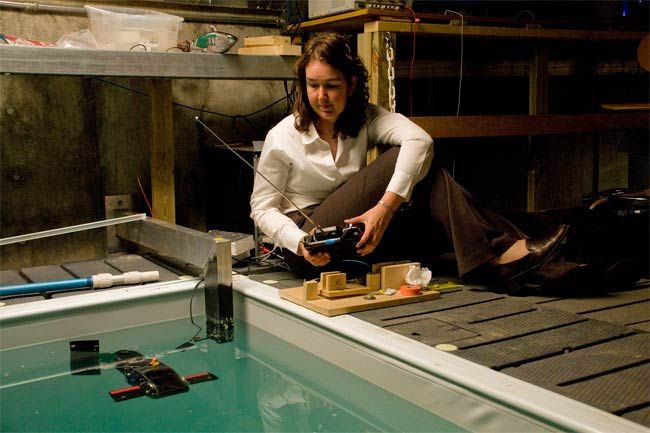Amazing Robo-Fish Work Together

A trio of robotic fish sporting tails and fins recently aced their first swim team test.
While most underwater robots rely on guidance from a scientist or satellite, the new robots, called Robofish, can work as a team by wirelessly communicating only with each other.
Kristi Morgansen, an aeronautics and astronautics engineer at the University of Washington, presented results from this swim test at the International Federation of Automatic Control's Workshop on Navigation, Guidance and Control of Underwater Vehicles.
The fish are about two feet long and wiggle through the water by using their fish-like tails and fins. The researchers say fins have advantages over propellers that are commonly used for underwater robots, in that fins produce less drag and noise, and allow the robots to make tight turns.
In the future, Morgansen and her colleagues say schools of ocean-going robots could work together to track groups of the real McCoy underwater, such as whales or dolphins (though these marine species are actually mammals, not fish), or even explore hard-to-reach caves, such as those tucked beneath ice.
In the lab, Morgansen and her colleagues programmed the robo-fish to either swim in the same direction or in different directions (in the latter case, each one would swim about 120 degrees from its neighbor).
Here's how the robots "talk" to each other: "One of them will send a message, and the rest of them know it's not their turn to talk and so they are listening," Morgansen told LiveScience. "There's a time during which they know there is a signal coming. If they receive it, they use it; if they don't, they keep following what they were doing."
Sign up for the Live Science daily newsletter now
Get the world’s most fascinating discoveries delivered straight to your inbox.
For instance, if the robotic fish are programmed to collect information in areas where "lots of things are happening," Morgansen said, "you don't want all of them to go to same place."
With three coordinated robots, they can relay their locality to teammates and signal the others to collect information at another "happening" spot.
"If you have some sort of event going on like an underwater eruption, you're not going to be able to get one vehicle to a bunch of places quickly," Morgansen said. And so the more underwater researchers, the better, as long as they don't all flock to the same location.
Next, Morgansen said she will test the teamwork of the three Robofish in a task more similar to what they would face in the ocean: The fishy robots will trail a remote-controlled toy shark.
The research was supported by grants from the National Science Foundation and the Air Force Office of Scientific Research.
- Video: Robotic Fish Work as a Team
- Image Gallery: Cutting-Edge Robots
- Vote for Your Favorite Robot
Jeanna Bryner is managing editor of Scientific American. Previously she was editor in chief of Live Science and, prior to that, an editor at Scholastic's Science World magazine. Bryner has an English degree from Salisbury University, a master's degree in biogeochemistry and environmental sciences from the University of Maryland and a graduate science journalism degree from New York University. She has worked as a biologist in Florida, where she monitored wetlands and did field surveys for endangered species, including the gorgeous Florida Scrub Jay. She also received an ocean sciences journalism fellowship from the Woods Hole Oceanographic Institution. She is a firm believer that science is for everyone and that just about everything can be viewed through the lens of science.












